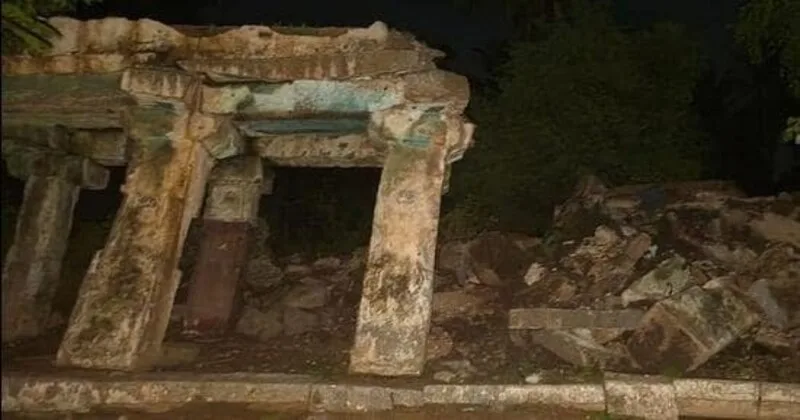A portion of the Virupaksha temple in Karnataka collapsed following torrential rains on Tuesday, May 21. The temple’s pavilion, or saalu mantap, was damaged. Conservationists blamed Archaeological Survey of India (ASI) officials for neglecting its protection and conservation, while ASI officials argued that restoration work was already underway and the rains led to its collapse.
Historical Significance of Virupaksha Temple
- Origins and Expansion: The temple dates back to the 7th century, gaining prominence and extensive expansion during the 14th century under the Vijayanagara Empire.
- Vijayanagara Empire: Founded by Harihara I of the Sangama dynasty, the empire became powerful from its strategic position on the Tungabhadra river.
- Architectural Significance: Known for its Dravidian temple architecture, the temple features grand gopurams (towering gateways), intricate carvings, and pillared halls.
- Cultural and Religious Hub: The temple flourished under Vijayanagara rulers, becoming a center for religious and cultural activities.
Restoration Work and Challenges
- ASI’s Role: The ASI is responsible for 57 out of the 95 nationally protected monuments in Hampi. The restoration work began in 2019, with the first phase completed in 2019-20 and the second in 2022-22.
- Pavilion Collapse: ASI officials noted that the pavilion’s pillars had deteriorated due to natural phenomena, including heavy rains. The restoration was planned, but the collapse occurred prematurely.
- Restoration Plans: Post-collapse, the ASI is dismantling the pavilion for restoration on a priority basis. A committee of senior archaeologists, conservationists, and engineers has been formed to assess damage and requirements.
Restoration Challenges and Funding
- Funding and Logistics: The ASI faces challenges related to funding, logistics, and human resources. Rs 8 crore was allocated in the last financial year for restoration in the Kalyan Karnataka region.
- Traditional Restoration Methods: The restoration requires the same type of stone initially used, and traditional methods are time-consuming. Restoring the dismantled pavilion is estimated to cost Rs 50 lakhs and is expected to be completed in three to four months.
Broader Concerns and Preservation Efforts
- Modern Additions and Alterations: Constant worship at the temple has led to many additions and alterations, impacting its historical setting.
- Impact of Modern Development: The growth of shops, restaurants, and road asphalting around the temple has adversely affected its setting. Managing the balance between modern uses and preserving the ancient site requires sensitivity.
Multiple Choice Questions (MCQs):
- What caused the collapse of a portion of the Virupaksha temple?
- A) Earthquake
- B) Torrential rains
- C) Fire
- D) Structural design flaw
- Answer: B) Torrential rains
- During which empire did the Virupaksha temple undergo extensive expansion?
- A) Maurya Empire
- B) Gupta Empire
- C) Vijayanagara Empire
- D) Chola Empire
- Answer: C) Vijayanagara Empire
- What architectural style is the Virupaksha temple known for?
- A) Mughal architecture
- B) Dravidian temple architecture
- C) Indo-Saracenic architecture
- D) Gothic architecture
- Answer: B) Dravidian temple architecture
- Who is responsible for the restoration work of the Virupaksha temple?
- A) Karnataka State Government
- B) Indian National Trust for Art and Cultural Heritage (INTACH)
- C) Archaeological Survey of India (ASI)
- D) UNESCO
- Answer: C) Archaeological Survey of India (ASI)
- What are some of the challenges faced by ASI in restoring the temple?
- A) Lack of interest from the public
- B) Funding, logistics, and human resources
- C) Opposition from local communities
- D) Unavailability of historical records
- Answer: B) Funding, logistics, and human resources
